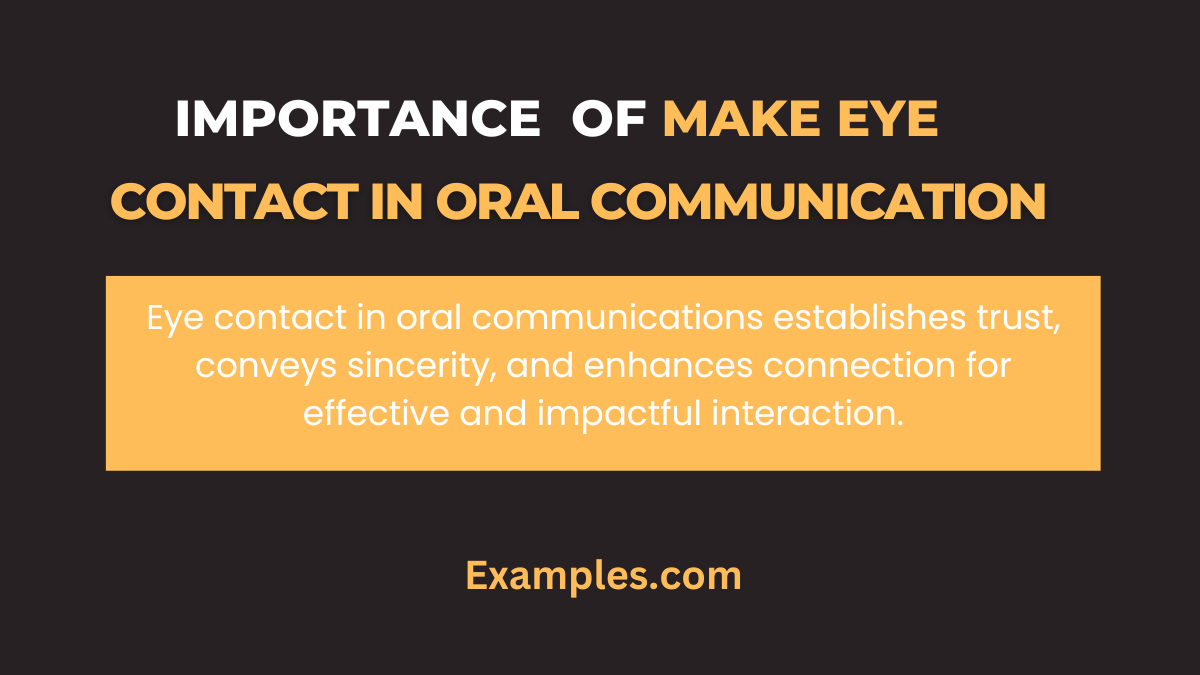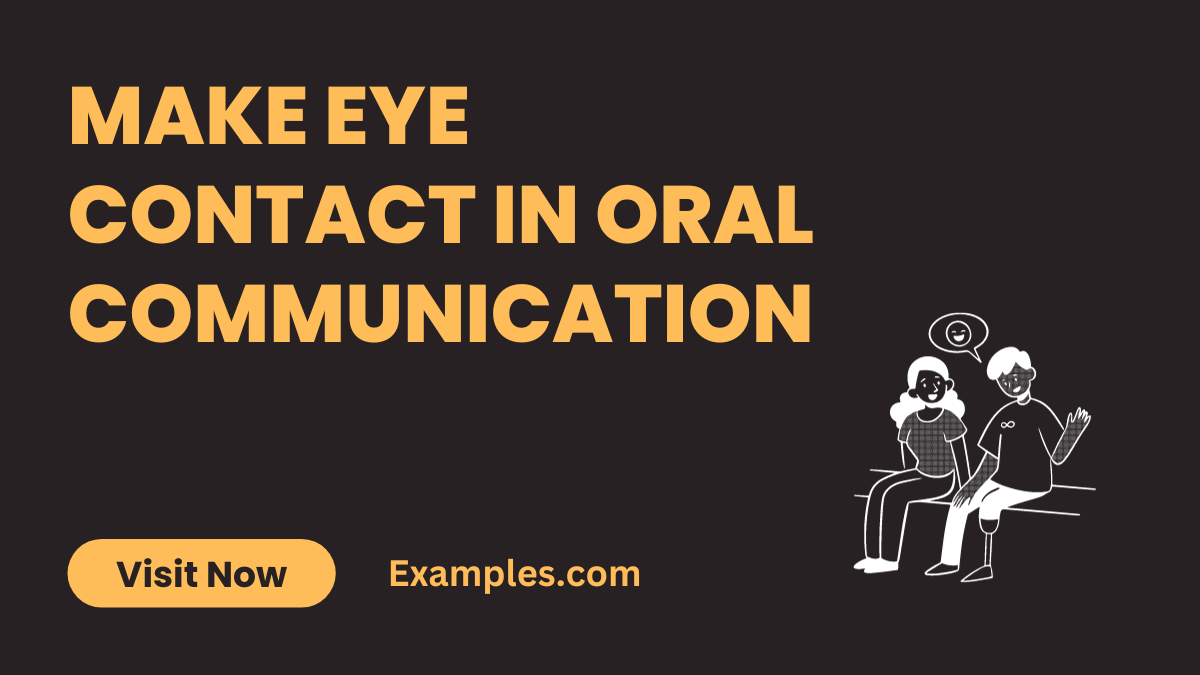19+ Make Eye Contact In Oral Communication Examples
Enhancing your oral communication involves mastering the art of making eye contact. This guide explores the significance of direct gaze in effective communication, providing examples to illuminate its impact on various contexts. Unlock the secrets of powerful connections and compelling expressions through the nuanced use of eye contact in verbal interactions.
What is Make Eye Contact In Oral Communication?

Make eye contact in oral communication refers to the deliberate act of establishing a visual connection with your audience. It involves maintaining direct gaze to convey confidence, attentiveness, and sincerity in your spoken interactions. This nonverbal communication skill plays a pivotal role in fostering engagement, building rapport, and conveying authenticity.
20 Make Eye Contact In Oral Communication Examples

Enhance your communication prowess with impactful eye contact. From job interviews to presentations, this comprehensive guide includes practical examples and expert insights. Boldly connect through eye contact to convey confidence and engagement, ensuring a memorable impression.
- Meeting Etiquette: Maintain eye contact to express attentiveness and convey active participation in discussions.
- Job Interviews: Project confidence by making consistent eye contact with interviewers, showcasing your sincerity and interest.
- Public Speaking: Command attention and build rapport with your audience by establishing strong eye contact during speeches.
- Networking Events: Forge meaningful connections by making eye contact, signaling openness and approachability.
- Conversational Engagement: Establish a genuine connection by maintaining eye contact during one-on-one conversations, fostering understanding.
- Presenting Ideas: Strengthen your message by using eye contact to engage listeners and emphasize key points.
- Expressing Empathy: Demonstrate empathy through eye contact, conveying understanding and emotional connection.
- Team Collaboration: Build trust within teams by making eye contact, fostering a sense of unity and shared purpose.
- Customer Interactions: Establish credibility and trust with customers through confident and sincere eye contact.
- Effective Leadership: Leaders use eye contact to inspire confidence, convey authority, and connect with team members.
- Negotiation Dynamics: Navigate negotiations with assertiveness and clarity by using eye contact strategically.
- Teaching and Training: Captivate your audience during educational sessions by maintaining eye contact, enhancing engagement.
- Expressing Gratitude: Reinforce sincerity when expressing gratitude by making eye contact, amplifying the impact of your words.
- Conflict Resolution: Use eye contact to diffuse tension during conflicts, promoting open communication and understanding.
- Giving Feedback: Strengthen feedback delivery with eye contact, demonstrating authenticity and fostering constructive dialogue.
- Crisis Communication: Navigate crisis situations with poise, using eye contact to convey reassurance and leadership.
- Storytelling Impact: Elevate storytelling by establishing eye contact, creating a more immersive and memorable narrative.
- Educational Presentations: Engage students effectively by using eye contact to connect with individuals and the entire class.
- Promoting Inclusivity: Foster an inclusive environment by making eye contact, signaling respect for diverse perspectives.
- Influencing Decisions: Persuade effectively by maintaining eye contact, establishing trust, and conveying conviction.
Make Eye Contact In Oral Communication Examples for Students
Enhance students’ communication skills through effective eye contact strategies. In classrooms, maintaining eye contact fosters engagement and collaborative learning. During group projects, encourage students to establish eye contact, promoting effective teamwork. Presentations become more impactful when students confidently make eye contact, capturing their peers’ attention. Whether seeking feedback or participating in extracurricular activities, students can leverage eye contact to convey sincerity and strengthen interpersonal connections.
- Classroom Participation: Boldly engage in discussions by making eye contact, signaling active involvement in the lesson.
- Group Projects: Foster teamwork by encouraging each team member to maintain eye contact, promoting effective communication.
- Presentations: Command attention during presentations by making eye contact, establishing a connection with your audience.
- Peer Interactions: Build strong connections with peers by maintaining eye contact during conversations, fostering camaraderie.
- Feedback Sessions: Enhance feedback delivery by making eye contact, conveying sincerity and encouraging constructive dialogue.
- Networking Opportunities: Stand out in networking events by confidently making eye contact, expressing openness and approachability.
- Collaborative Learning: Promote active engagement in collaborative learning environments by encouraging eye contact among students.
- Extracurricular Activities: Excel in extracurricular activities by making eye contact, showcasing leadership and effective communication skills.
- Interactive Workshops: Maximize learning in workshops by actively maintaining eye contact, ensuring active participation and understanding.
- Professional Development: Prepare students for future success by emphasizing the importance of eye contact in professional settings, building essential communication skills.
Make Eye Contact In Oral Communication Examples for Interview
Master the art of eye contact for successful job interviews. Establish confidence and professionalism by maintaining eye contact throughout the interview. Use strategic eye contact to emphasize qualifications, creating a lasting impression on potential employers. Strike the right balance in eye contact to convey genuine interest without appearing assertive or disinterested. Navigate behavioral questions with poise, using eye contact to showcase experiences and problem-solving abilities. From addressing weaknesses to negotiating, leverage eye contact to express authenticity and leave a positive impact on interviewers.
- Introduction: Boldly establish eye contact during the introduction, setting a positive tone for the interview and expressing enthusiasm.
- Answering Questions: Convey confidence and sincerity by making eye contact while responding to interview questions, showcasing genuine interest.
- Discussing Qualifications: Emphasize key qualifications by maintaining eye contact, ensuring the interviewer recognizes your strengths and expertise.
- Handling Behavioral Questions: Navigate behavioral questions with poise by using eye contact to convey your experiences and problem-solving abilities.
- Addressing Weaknesses: Show resilience and self-awareness by making eye contact while discussing weaknesses, emphasizing your commitment to growth.
- Asking Questions: Establish engagement by making eye contact while asking insightful questions about the company or role, showcasing genuine interest.
- Cultural Fit: Highlight your cultural fit by using eye contact to express alignment with the company’s values and mission during the interview.
- Closing Statements: Leave a lasting impression by maintaining eye contact during closing statements, expressing gratitude and enthusiasm for the opportunity.
- Follow-up Communication: Reiterate your interest through strategic eye contact in follow-up emails, reinforcing your professionalism and enthusiasm for the position.
- Negotiation: Navigate salary negotiations confidently by using eye contact to convey your value and commitment to the organization, fostering a positive negotiation environment.
How do you Make Eye Contact In Oral Communications While Presenting?
Incorporate purposeful eye contact by scanning the audience, pausing at intervals, and connecting with individuals. Balance gaze to engage everyone, creating a dynamic and inclusive presentation style. Cultivate confidence, ensuring eye contact enhances your message delivery, making your communication more impactful and memorable.
What is the Importance of Eye Contact In Oral Communications?

Eye contact establishes trust, enhances connection, and conveys sincerity. It fosters engagement, captures attention, and signals confidence, strengthening the speaker-listener relationship for effective communication.
Tips for Effective Make Eye Contact In Oral Communications
- Scan the Audience: Boldly connect with different audience members, ensuring inclusive engagement.
- Interval Pauses: Pause at intervals to maintain eye contact, enhancing your presence and message delivery.
- Balance Gaze: Distribute eye contact evenly, ensuring all audience segments feel engaged and included.
- Cultivate Confidence: Build confidence to establish a strong and impactful presence during oral communications.
- Memorable Delivery: Make eye contact purposeful to create a lasting impression and enhance the memorability of your message.
In conclusion, making eye contact in oral communication is a fundamental aspect of effective interaction. It serves as a powerful tool for establishing trust, engagement, and conveying your message with sincerity. By incorporating the techniques and tips discussed in this article, you can improve your ability to maintain eye contact during conversations, presentations, and speeches. Remember that practice and confidence-building are key to mastering this skill, and the benefits of enhanced eye contact are well worth the effort. By incorporating these strategies and exploring these resources, you’ll be better equipped to harness the power of eye contact in your oral communication endeavors.



